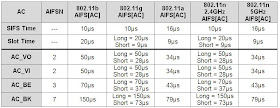Read the Entire Wi-Fi Quality of Service 5-Part Series:
- Part 1 - Background Information
- Part 2 - IEEE 802.11e Principles
- Part 3 - User Priorities, Access Categories and Queues
- Part 4 - Arbitration Interframe Spacing
- Part 5 - Contention Window and Final Thoughts
The second QoS design change implemented as part of the 802.11e amendment and WMM certification is replacement of the one-size-fits all Distributed Inter-Frame Spacing (DIFS) for all data and management frames, with Arbitration Inter-Frame Spacing (AIFS) which is dependent on the access category and queue of the frame waiting transmission.
Arbitration Inter-Frame Spacing (AIFS) defines different inter-frame gaps for traffic from each of the 4 priority queues. This replaces the original DCF Inter-Frame Spacing (DIFS) which defined only a single inter-frame gap value for all data frames. Using AIFS, each frame awaiting transmission must wait until the medium is declared to be available through Clear Channel Assessment (CCA) and the Network Allocation Vector (NAV), not discussed here for brevity. Once the medium is available, each logical station (one for each priority queue) must wait the defined inter-frame space time based on the queue to which the traffic is assigned.
Each of the 4 priority queues has a defined inter-frame space value corresponding to the priority assigned to the queue. For example, the Voice queue is the highest priority and as such has the lowest inter-frame space timer. The AIFS timers assigned by IEEE 802.11e are all defined as 1 Short Inter-Frame Spacing (SIFS) value plus a variable number of slots times (AIFSN) which are defined by the physical layer encoding method in-use (CCK, DSSS, OFDM).
The AIFS Number (AIFSN) values are administrator configurable, with default values defined as the following:
- Voice Queue 1 SIFS + 2 * slot time (AIFSN = 2)
- Video Queue 1 SIFS + 2 * slot time (AIFSN = 2)
- Best Effort Queue 1 SIFS + 3 * slot time (AIFSN = 3)
- Background Queue 1 SIFS + 7 * slot time (AIFSN = 7)
Therefore, the default AIFS values for each PHY are as follows:
Note – 802.11g and 802.11n when operating in the 2.4 GHz spectrum use long slot times when legacy 802.11b is present, and use the short slot times when no legacy stations are present. This is done for backwards compatibility.
Here is an illustration of AIFS in action, with [X] representing sample User Priorities for differentiated inter-frame spacing between access categories. Clearly, frames with UP = 0 (AC_BE) will wait a longer IFS than frames with UP = 6 (AC_VO), thereby prioritizing voice AC traffic.
(Figure 2-9 courtesy of “Voice over Wireless LAN 4.1 Design Guide” page 2-11, by Cisco Systems)
The AIFSN field within the EDCA Parameter Set information element is 4 bits long, with a minimum value of 2 defined in the standard and a maximum value of 15 based on the field length limitation.
In this manner, arbitration inter-frame spacing allows a statistical advantage for traffic in higher priority queues because those frames are not required to wait as long prior to decrementing their random backoff timers.
We're almost, but not quite, finished with the technical details of wireless QoS. In my final post, I'll detail enhancements to the contention window value selection, which determines the random backoff range used by stations prior to transmitting. I'll also wrap it all up together in a nice bow, and provide a few very useful external links for further reading.
-Andrew



Andrew - Nice one. I am happy to be first one to comment although it was published in 2010. :)
ReplyDeleteIf it can be updated with the 802.11-2012 clauses that will be better. Maybe the only change is the section number. :)
Thanks again.
Amjad